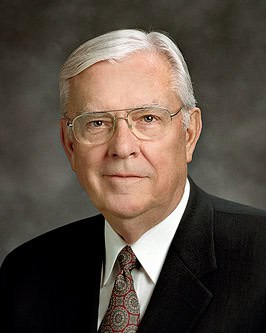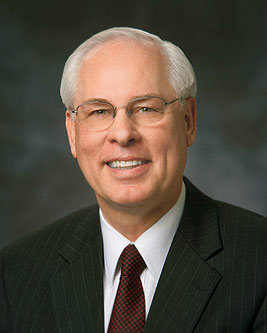SEARCH BY LIST
 Hyrum Smith: “Firm As the Pillars of Heaven”
Hyrum Smith: “Firm As the Pillars of Heaven”
Hyrum gave unfailing service to the Church. In 1829, he was among a handful of individuals who were allowed to view the gold plates from which the Book of Mormon was translated, and for the rest of his life he testified to the divine nature of the Book of Mormon as one of the Eight Witnesses who “had seen the plates with his eyes and handled them with his hands.” He was among the first to be baptized in this gospel dispensation. At age thirty, he was the oldest of the six men chosen in 1830 to formally organize The Church of Jesus Christ of Latter-day Saints. In 1831, he stood before the Ohio conference and pledged “that all he had was the Lord’s and he was ready to do his will continually.” In 1833, when the Lord chastised the Church for delaying the start of the Kirtland Temple, Hyrum was the first to start digging its foundation. As chairman of the temple committee, Hyrum rallied the Church to perform the seemingly impossible task of building the Kirtland Temple when most Church members literally had nothing to give to the cause. A few years later he repeated this service with the building of the Nauvoo Temple. Hyrum served in the Ohio bishopric, on the first high council, as Patriarch, counselor in the First Presidency, and finally as one of only two men ever to hold the office of Assistant President of the Church. Hyrum served many missions for the Church. During one mission, traveling from Kirtland to Indiana, he endured one of his greatest trials when his first wife, Jerusha, died soon after giving birth to his sixth child. Hyrum’s mother, Lucy Mack Smith, wrote that Jerusha’s death “wrung our hearts with more than common grief. … She was a woman whom everybody loved.” Although Hyrum was grieved, his faith was unshaken; his determination to serve Heavenly Father and his church never faltered. I believe God rewarded his faithfulness by bringing into his life one of the great women of Church history, Mary Fielding, whom he subsequently married. Together they built an extraordinary legacy of love and discipleship.
 Live True to the Faith
Live True to the Faith
One of the most wonderful chapters in the history of the Church occurred when Wilford Woodruff, an Apostle of the Lord, was teaching the restored gospel of Jesus Christ throughout Great Britain in 1840—just 10 years after the establishment of the Church. Wilford Woodruff and other Apostles had focused their work in the Liverpool and Preston areas of England, with considerable success. Elder Woodruff, who later became President of the Church, was constantly praying to God to guide him in this very important work. His prayers led to the inspiration to go to a different place to teach the gospel. President Monson has taught us that when we get the inspiration from heaven to do something, we do it now—we don’t procrastinate. That is exactly what Wilford Woodruff did. With clear direction from the Spirit to “go … south,” Elder Woodruff left almost immediately and traveled to a part of England called Herefordshire—farming country in the southwest of England. Here he met a prosperous farmer named John Benbow, where he was welcomed “with glad hearts and thanksgiving”. A group of over 600 people, who called themselves the United Brethren, had been “praying for light and truth”. The Lord sent Wilford Woodruff as an answer to their prayers. Elder Woodruff’s teaching bore fruit immediately, and many were baptized. Brigham Young and Willard Richards joined him in Herefordshire, and the three Apostles had remarkable success. In only a few months, they organized 33 branches for the 541 members who had joined the Church. Their remarkable work continued, and ultimately almost every one of the members of the United Brethren were baptized into The Church of Jesus Christ of Latter-day Saints.
 “May the Kingdom of God Go Forth”
“May the Kingdom of God Go Forth”
Today, as never before, have I more fully realized the importance of that last requirement: that this presidency, in the Lord’s language, must be upheld by the confidence, the faith, and the prayers of the Church—which means, of course, the entire membership of the Church. We witnessed a short while ago the outpouring of love and fellowship that was in evidence in the great regional conference of our wonderful Lamanite Saints from Central America and Mexico, assembled in Mexico City in August. Over 16,000 Saints were gathered together in a great auditorium, where they sustained their General Authorities. Again, in the mighty demonstration of this solemn assembly, I am moved with emotions beyond expression as I have felt the true love and bonds of brotherhood. There has been here an overwhelming spiritual endowment, attesting, no doubt, that in all likelihood we are in the presence of personages, seen and unseen, who are in attendance. Who knows but that even our Lord and Master would be near us on such an occasion as this, for we, and the world, must never forget that this is his church, and under his almighty direction we are to serve! . . On the sacred occasion three months ago when I began to sense the magnitude of the overwhelming responsibility which I must now assume, I went to the holy temple. There, in prayerful meditation, I looked upon the paintings of those men of God—true, pure men, God’s noblemen—who had preceded me in a similar calling. A few days ago in the early morning hours, in my private study at home and all alone with my thoughts, I read the tributes paid to each of the Presidents by those who had been most closely associated with each of them.
 “Thus Shall My Church Be Called”
“Thus Shall My Church Be Called”
Today I would like to speak about a name. We are all pleased when our names are pronounced and spelled correctly. Sometimes a nickname is used instead of the real name. But a nickname may offend either the one named or the parents who gave the name. The name of which I shall speak is not a personal name, yet the same principles apply. I refer to a name given by the Lord: “Thus shall my church be called in the last days, even The Church of Jesus Christ of Latter-day Saints.” Note carefully the language of the Lord. He did not say, “Thus shall my church be named.” He said, “Thus shall my church be called.” Years ago, its members were cautioned by the Brethren who wrote: “We feel that some may be misled by the too frequent use of the term ‘Mormon Church.’” Before any other name is considered to be a legitimate substitute, the thoughtful person might reverently consider the feelings of the Heavenly Parent who bestowed that name. . . The last word in the title is Saints. I smile when I remember a comment made after my call to the Quorum of the Twelve. A doctor friend relayed a report made at a professional meeting that “Dr. Nelson was no longer practicing cardiac surgery because his church had made him ‘a saint.’” Such a comment was not only amusing but revealing. It evidenced unfamiliarity with the language of the Bible, in which the word saint is used much more frequently than is the term Christian. The word Christian appears in only three verses of the King James Version of the Bible. One verse describes the historical fact that “disciples were called Christians first in Antioch”; another quotes a sarcastic nonbeliever, King Agrippa; and the third indicates that one known as “a Christian” must be prepared to suffer. . . The term latter-day is an expression especially difficult for translators who labor in languages in which there is not a good equivalent term. Some translations may suggest last day. It is true that scriptures foretell the final days of the earth’s temporal existence as a telestial sphere. The earth will then be renewed and receive its paradisiacal, or terrestrial, glory. Ultimately, the earth will become celestialized. But its last days must be preceded by its latter days!
